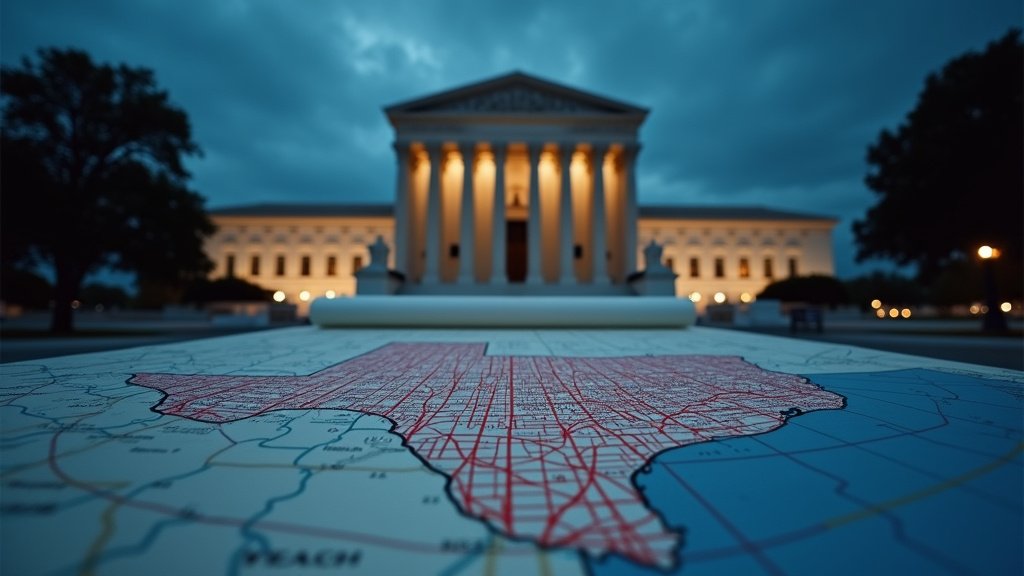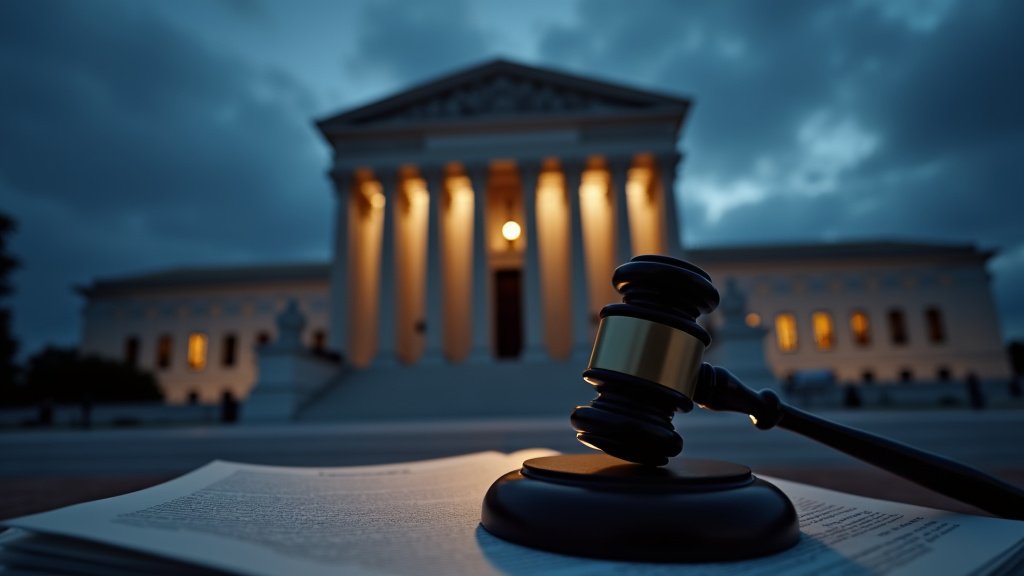A federal court has blocked Texas from using its newly approved congressional map for the 2026 midterm elections, ruling that the state engaged in racial gerrymandering. This significant Texas Gerrymandering Ruling, which mandates the use of the 2021 congressional map for the upcoming elections, represents a substantial setback for Republicans and a victory for Democrats. Attorney General Ken Paxton has announced his intention to appeal the Texas Gerrymandering Ruling to the U.S. Supreme Court.
The three-judge panel, in a 2-1 decision, found substantial evidence that the 2025 map, passed by the Republican-controlled legislature, was drawn with race as a determining factor, thereby violating the U.S. Constitution and the Voting Rights Act of 1965. While partisan gerrymandering is generally considered legal, racial gerrymandering is not. The court’s majority opinion, authored by U.S. District Judge Jeffrey V. Brown, stated that “substantial evidence shows that Texas racially gerrymandered the 2025 Map”. The Texas Gerrymandering Ruling noted that the map’s critics have a strong chance of prevailing at trial, impacting the future of texas congressional map integrity.
The blocking of the new map upends the strategies of many candidates who had begun campaigning or planning their races based on the lines drawn in 2025. Republicans, who had hoped the new texas congressional map would yield them as many as five additional House seats, may now need to reassess their electoral strategies in light of the Texas Gerrymandering Ruling. Conversely, Democrats who were drawn out of their seats or into districts with incumbent colleagues may now have a clearer path back to Congress.
Background of the Redistricting Controversy and the Texas Gerrymandering Ruling
The controversy began earlier in 2025 when, following pressure from the Trump administration to gain more Republican seats in Congress, the Texas Legislature convened a special session to redraw the state’s congressional districts. The new texas congressional map was passed in August, with Republicans aiming to secure a more favorable political landscape ahead of the critical 2026 midterm elections. This move by Texas was part of a broader national trend, with other Republican-led states like Missouri and North Carolina also redrawing their maps to benefit the GOP, while some Democratic states, such as California, took steps to counteract these efforts in political redistricting.
Civil rights groups, including MALDEF (Mexican American Legal Defense and Educational Fund) and the League of United Latin American Citizens (LULAC), along with other minority voters, swiftly challenged the new map, alleging it diluted the voting power of Black and Hispanic Texans and constituted illegal racial gerrymandering. They argued that the map dismantled existing majority-minority districts and reduced the number of districts where minorities form a majority of the voting-age population, a key concern in the texas gerrymandering lawsuit.
A key element in the court’s consideration was a July letter from the U.S. Department of Justice (DOJ), which urged Texas to dismantle four Democratic-held congressional districts deemed unconstitutional due to their racial makeup, directly referencing concerns about racial gerrymandering. While Texas officials, including Governor Greg Abbott, cited the DOJ letter as a basis for redistricting, the court’s majority found that the state’s response went beyond partisan considerations and became a deliberate act of racial gerrymandering. Judge Brown noted that the DOJ letter itself contained “so many factual, legal and typographical errors” but that the state leaders’ repeated references to it as an impetus for redistricting were significant. The court also observed that the map’s creators seemed to prioritize eliminating coalition districts and creating new majority-Hispanic districts, driven by race rather than solely partisan goals, which influenced the texas gerrymandering lawsuit outcome.
Implications and Candidate Reactions to the Texas Gerrymandering Ruling
The federal court’s Texas Gerrymandering Ruling has immediate and profound implications for the upcoming 2026 election cycle. With the 2021 map reinstated, candidates who had already filed or were preparing to run under the new texas congressional map must now re-evaluate their campaigns. For instance, Democratic Congressman Lloyd Doggett, who had indicated he would not seek re-election under the 2025 map due to a challenging primary, has now announced he will run again in his district, assured by the return to the 2021 lines.
Republicans who had committed to running in newly gerrymandered districts face uncertainty following this court ruling. State Rep. Briscoe Cain, initially a top candidate for the redrawn District 9, stated his campaign would continue, asserting the validity of the map passed by the legislature. However, the broader impact suggests a scramble for many GOP candidates, particularly those whose planned districts have been significantly altered or eliminated by the court’s injunction.
The ruling also has significant implications for the composition of Texas’s congressional delegation. The state currently has 25 Republicans and 12 Democrats in the U.S. House of Representatives. The 2025 map was designed to increase the Republican advantage, potentially by five seats, which would have bolstered the party’s slim majority in Congress. The court’s decision aims to prevent the use of unconstitutional racial classifications for congressional representation for at least two years, impacting texas elections 2026.
Legal Path Forward and Official Statements on the Texas Gerrymandering Ruling
Texas Attorney General Ken Paxton has vehemently opposed the Texas Gerrymandering Ruling, labeling it “clearly erroneous” and a move by the “radical left” to undermine the will of the people. He stated that the “Big Beautiful Map,” as he referred to the 2025 map, was “entirely legal and passed for partisan purposes”. Paxton confirmed his office would appeal the decision directly to the U.S. Supreme Court, expressing confidence that the conservative-leaning court would uphold Texas’s right to engage in partisan redistricting, a key aspect of election law.
Governor Greg Abbott echoed Paxton’s sentiments, asserting that the Legislature redrew the maps “to better reflect Texans’ conservative voting preferences – and for no other reason”. He dismissed claims of discrimination as “absurd” and unsupported by evidence presented during the trial regarding the texas congressional map.
On the other side, civil rights organizations and Democratic leaders have celebrated the court’s Texas Gerrymandering Ruling. MALDEF President and General Counsel Thomas A. Saenz stated that the court recognized the map “went too far in dismantling minority voting power on the basis of race”. U.S. Rep. Lizzie Fletcher described the map as an attempt to make it “harder for minority Texans” to have an impact in elections. The ruling is seen as a significant win for voting rights advocates and a crucial development in the ongoing national debate over political redistricting.
The appeal to the Supreme Court means the ultimate fate of the 2025 congressional map remains uncertain, with the state’s candidates and voters awaiting a final decision that could reshape the political landscape for years to come. The deadline for candidates to file for the 2026 elections is December 8, adding urgency to the legal proceedings. This ongoing legal battle highlights the contentious nature of redistricting and its critical role in determining political power, particularly after this significant Texas Gerrymandering Ruling.
This Top News story from Texas is trending as the nation watches the unfolding legal drama surrounding the texas congressional map. The outcome will likely influence redistricting efforts in other states as the 2026 election cycle intensifies, and could impact future applications of the Voting Rights Act.






